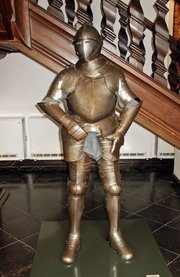Armour
|
|
- For the work of fiction, see Armor (novel).
Greek_Hoplite.jpg
Armour (spelled armor in American English), is protective clothing intended to defend its wearer from intentional harm in combat and military engagements, typically associated with soldiers. Armour has been used throughout recorded history, beginning with hides, leather, and bone, before progressing to bronze, then steel during the middle ages, to modern kevlar and ceramics.
Armour was also commonly used to protect war animals, such as war horses and elephants. Armour for war horses was called "barding". Armour has also been produced for hunting dogs that hunt dangerous game, such as boars. Since World War I, armoured fighting vehicles are protected by vehicle armour.
Armour is also a heavily armoured military force or organization, such as heavy infantry or heavy cavalry (as opposed to light infantry or cavalry). In modern armoured warfare, armoured units equipped with tanks serve the historic role of heavy cavalry, and belong to the armoured branch in a national army's organization (sometimes, the armoured corps). Heavy infantry have been replaced by mechanized infantry.
| Contents |
History
Throughout human history, the development of armor has always been parallel to the development of increasingly more efficient weaponry on the battlefield. An arms race across multiple civilisations to create better protection without sacrificing mobility.
In European history, well known armor types include the lorica segmentata of the Roman legions, the chainmail hauberk of the early medieval age, and the full steel plate armor worn by later medieval knights. In East Asian history, lamellar armor and brigandine was popular. Chinese influence in Japan would result in the Japanese adopting Chinese styles, and developing them into the 'samurai armor' we know today .
Plate armour
Main article: plate armour
Probably the most recognised style of armour in the world, associated with the knights of Middle to Late Medieval Europe, all parts of the human body have been fitted with specialised steel pieces, typically worn over linen or woollen underclothes and attached to the body via leather straps and buckles, with mail (maille) protecting those areas that could not be fitted with plate (the backs of the knee for instance). Well known constituent parts of plate-armour include the helm, gauntlets, gorget or 'neckguard', breastplate, and greaves worn on the lower legs.
Typically, full-body plate armour was custom made for the individual. This was understandably a very time-consuming and expensive undertaking, costing as much as a family house or high-powered car in today’s money. As such, it was almost exclusively the luxury of the noble and landed classes, with soldiers of lower standing generally wearing cheaper armour (if at all) typically limited to a helm and a breastplate. Full plate armour made the wearer virtually impervious to sword blows as well as providing some protection against arrows, bludgeons and even early musket shot. Although sword edges could not penetrate the relatively thin (as little as 2 mm) plate, they could cause serious concussive damage via the impact. Also, although arrows shot from bows could often pierce early plate at close range, later improvements in the steel forging techniques and armour design made even this line of attack increasingly difficult. By its apex, toughened steel plate was almost impregnable on the battlefield. Knights were instead increasingly felled by blunt weapons like maces or warhammers that could send concussive force through the plate armour resulting in injuries such as broken bones, organ haemorrhage and/or head trauma. Another tactic was to attempt to strike though the gaps between the armour pieces, using daggers to attack the Knight's eyes or joints.
Contrary to common misconceptions, a well-made suit of medieval 'battle' armour (as opposed to the primarily ceremonial 'parade' and 'tournament' armours popular with kings and nobility of later years) hindered its wearer no more than the equipment carried by soldiers today. An armoured Knight (trained since his teens in its wearing) could comfortably run, crawl, climb ladders, as well as mount and dismount his horse without recourse to a crane (a myth originating from Mark Twain's A Connecticut Yankee In King Arthur's Court). A full suit of medieval plate is thought to have weighed little more than 60 lb (27 kg) on average, considerably lighter than the equipment often carried by the elite of today’s armies,Zbroja_Batorego.jpg
Modern personal armour
Today, bullet proof vests made of ballistic cloth (e.g Kevlar or Dyneema) and ceramic or metal plates are common among police forces, security staff and in some branches of the military. For infantry applications, lighter protection (historically known as a flak jacket) is often used to protect soldiers from grenade fragments and indirect effects of bombardment, but usually not small arms fire. This is because assault rifles usually fire harder, higher-energy bullets than pistols, and the increased protection needed to stop these would be too cumbersome and heavy to use in combat.
See also
- Military uniforms
- Battledress
- Shield
- Military history
- Vehicle armor
- List of AFVs, Panzer
- Rolled Homogeneous Armour
External links
- Medieval Armor and its History (http://www.swuklink.com/BAAAGEHQ.php)
- Medieval Armor and Weapons (http://www.medieval-armory.com/mewe.htm)
- Medieval Armour Reproduction and History (http://www.arador.com/main/index.html)de:Rüstung
fr:Armure he:שריון ja:鎧 nl:Harnas pl:Zbroja ru:Доспехи sv:Brynja zh:装甲

